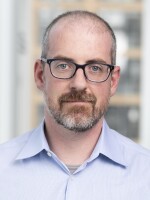AYESHA RASCOE, HOST:
Last week, NPR's Geoff Brumfiel reported from a top-secret underground laboratory where scientists study nuclear weapons. We wanted to know, how in the world did he get down there? So we asked him, and he filed this reporter's notebook with the backstory.
GEOFF BRUMFIEL, BYLINE: I've gotten into a few of these highly classified places over the years, and there's not really any trick to it. You just sort of have to keep asking. The first time I did for this one was actually in Vienna, Austria, believe it or not, at a technical conference about underground nuclear testing. Speaking was the woman who was in charge of America's nuclear weapons. Her name is Jill Hruby.
(SOUNDBITE OF ARCHIVED RECORDING)
JILL HRUBY: Hello, everyone. It's a pleasure and honor...
BRUMFIEL: The world's major nuclear powers haven't actually tested weapons in decades, and Hruby in this speech was making it very clear that the U.S. wanted to keep it that way.
(SOUNDBITE OF ARCHIVED RECORDING)
HRUBY: We have not conducted a nuclear explosive test since 1992 and have no plans to do so.
BRUMFIEL: Then she started talking about what the U.S. is doing, how they run computer simulations and they do all kinds of experiments to make sure the nuclear weapons still work. Some are done at government laboratories...
(SOUNDBITE OF ARCHIVED RECORDING)
HRUBY: Other experiments are conducted underground at the former Nevada test site.
BRUMFIEL: ...Where the nuclear tests used to happen. Now, I've heard about these underground experiments. They're highly classified. But Hruby starts talking about hosting visitors down there to show them what they're up to. So after she is done, I remember going up to her in front of the Hofburg Palace, and I think I might have just asked her right there about whether she'd be open to reporters visiting. I didn't get an answer right away, but I kept asking. And a year and a half later...
UNIDENTIFIED PERSON #1: All right. Good morning, everybody.
BRUMFIEL: ...I was on a tour bus north of Las Vegas with a handful of other reporters driving across this beautiful, empty desert landscape where the U.S. government used to detonate nuclear weapons. About 800 people work out there today.
UNIDENTIFIED PERSON #1: So we're kind of our own little city, which is required when you just experienced the drive that our workforce does every morning.
BRUMFIEL: OK. So I'm in. I'm ready to go underground, but then comes the safety video.
(SOUNDBITE OF ARCHIVED RECORDING)
UNIDENTIFIED NARRATOR: Welcome to PULSE, the Principal Underground Laboratory for Subcritical Experimentation.
BRUMFIEL: And it starts out, like, pretty normal.
(SOUNDBITE OF ARCHIVED RECORDING)
UNIDENTIFIED NARRATOR: Safety is the highest priority of PULSE.
BRUMFIEL: But this is an underground lab where they blow up weapons-grade plutonium with high explosives, so pretty quickly, things get weird.
(SOUNDBITE OF ARCHIVED RECORDING)
UNIDENTIFIED NARRATOR: Any type of underground fire will generate poisonous carbon monoxide gas.
BRUMFIEL: If that happens, put on your emergency respirator.
(SOUNDBITE OF ARCHIVED RECORDING)
UNIDENTIFIED NARRATOR: The air you are breathing may get warm or hot. It may be hot enough to blister the inside of your mouth.
BRUMFIEL: So basically, if anything happens, we're dead, but somebody should be able to get our corpses to the surface.
But, look, you know, I'm into it. I'm one of the last Cold War kids. I've got a background in physics. This is really my jam. So hard hat, check. Flashlight, check. Emergency respirator, check. Let's go. We step into this old mining elevator.
UNIDENTIFIED PERSON #2: All right, watch your step getting onto the cage.
BRUMFIEL: And whoosh, we just drop it to pitch blackness. And when that door opens...
(SOUNDBITE OF DOOR OPENING)
BRUMFIEL: ...I'm just like, wow, I'm actually here. I've seen pictures of these tunnels for decades, and I never thought I'd get down here. David Funk leads us around.
DAVID FUNK: Yeah. We'll go down to the zero room. So you guys know we called ground zero where we did our nuclear explosive testing? So we call it the zero room. It sort of hearkens back to that date.
BRUMFIEL: In fact, they told us they hadn't had reporters down here since the '90s when I was in high school. And, you know, I'm trying to play cool and let the other reporters ask their questions, but it's clear I'm way too excited.
FUNK: Just prior to what would be the nuclear phase...
BRUMFIEL: And how much plutonium - sorry. How much plutonium will you be using in these tests?
FUNK: Yeah, no.
BRUMFIEL: You can't tell us.
FUNK: Yeah. Right.
(SOUNDBITE OF MACHINERY CLANKING)
BRUMFIEL: The science they're doing in these tunnels - they do it so America doesn't have to test any more nuclear weapons. But there's a new arms race starting, and there's talk of nuclear testing again. Most people don't know about it, just like they don't know about these secret tunnels under the desert. Geoff Brumfiel, NPR News.
(SOUNDBITE OF DAFT PUNK'S "END OF LINE") Transcript provided by NPR, Copyright NPR.
NPR transcripts are created on a rush deadline by an NPR contractor. This text may not be in its final form and may be updated or revised in the future. Accuracy and availability may vary. The authoritative record of NPR’s programming is the audio record.



